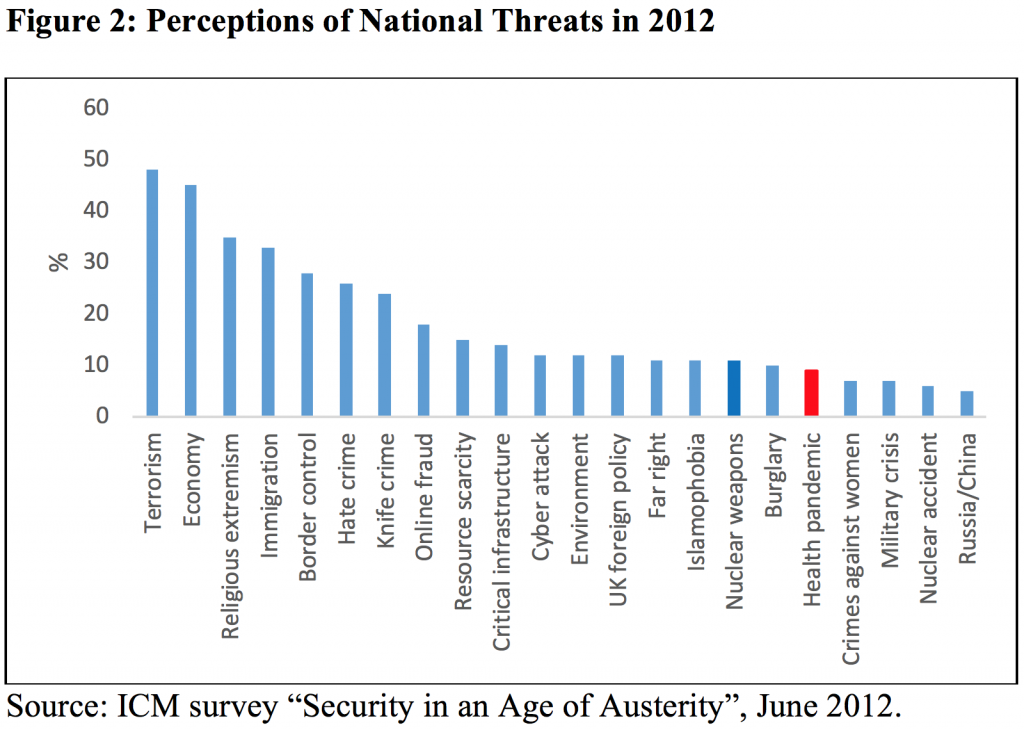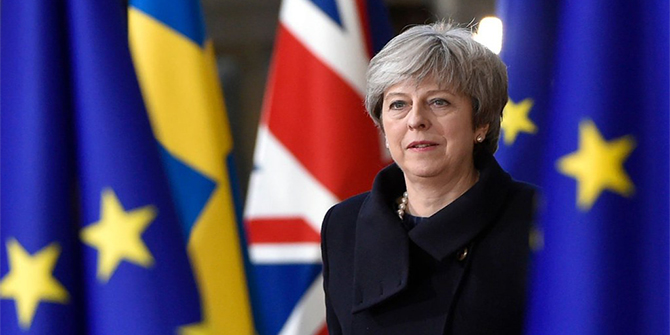
 Using public opinion data, Dan Stevens and Nick Vaughan-Williams explain that a pandemic was simply not seen as a major threat by the British public prior to 2020, despite its prominence in government security strategy. Going forward, and given pandemics will continue to be a major threat, public knowledge needs to remain close to where it is now as opposed to where it seems to have been before COVID-19.
Using public opinion data, Dan Stevens and Nick Vaughan-Williams explain that a pandemic was simply not seen as a major threat by the British public prior to 2020, despite its prominence in government security strategy. Going forward, and given pandemics will continue to be a major threat, public knowledge needs to remain close to where it is now as opposed to where it seems to have been before COVID-19.
As well as experiencing the relatively recent pandemic scares of H1N1 (swine flu) in 2009 and Ebola in 2013, governments have been aware of the possibility of something like COVID-19 for many years. In 2019, for example, the US government carried out a full-scale simulation of a pandemic with many eerie similarities to COVID-19, while the UK government cited a health pandemic as among the country’s greatest security threats in successive National Security Strategies (NSS) in 2010 and 2015. Those NSS placed security threats into three tiers based on their combination of likelihood and impact. Tier Three included threats to the fuel supply or attacks on overseas territories or military bases; Tier Two included threats such as the effects of a financial crisis and of organized crime. In both 2010 and 2015 a global health pandemic was in the first tier, alongside terrorism or an international military conflict; indeed, the 2010 NSS refers to:
…a high probability of another influenza pandemic occurring and, based on a range of data, possible impacts of a future pandemic could be that up to one half of the UK population becomes infected, resulting in between 50,000 and 750,000 deaths in the UK, with corresponding disruption to everyday life.
While there is debate about the extent to which the UK government was prepared for a pandemic like COVID-19, another aspect to this question of preparedness is the extent to which the public was aware of, or primed for, this Tier One threat in the same way that it is for other Tier One threats, such as terrorism or cyber-attacks. For just as the public is expected and encouraged to be vigilant in public spaces for terrorism in campaigns such as National Rail’s “See It. Say It. Sorted”, a successful response to COVID-19 has depended on the public taking the threat seriously and behaving accordingly with measures such as social distancing. That does not appear to have happened, however, in the absence of the far stricter guidance announced by the government on 23 March 23. Why?
We have survey and focus group data that provide a glimpse into what fear and awareness in everyday life was like for the UK public before COVID-19. In 2012 we conducted a survey with ICM in which we asked a national sample of more than 2,000 UK citizens to tell us what they regarded as threats to the world, the nation, their community, and to them and their family. We gave respondents a choice of 22 different threats, from terrorism and an international military crisis – both of which appear as Tier One threats in the government’s NSS – to “everyday threats” that do not, such as knife crime and online fraud or identity theft. The 22 threats also included “a health pandemic, e.g., avian flu” (while ultimately resulting in few deaths, it was reported in 2012 that avian flu “could become one of history’s worst pandemics.”). Respondents could identify as many of the 22 issues as threats as they wanted.
Figure 1 shows the proportion of respondents who regarded a health pandemic as a global threat and Figure 2 as a national threat, compared to the 21 other security threats. Roughly one in five respondents identified a health pandemic as a global threat and one in ten as a national threat; this compares to one in two or more who could see terrorism as a threat. Compared to all other threats, a health pandemic also ranked a long way down the list of concerns – 16th as a global threat and 18th as a national threat. The picture does not change much if we look at community threats (6%) or threats to the individual (8%) (although people seem to see fewer threats in general in those areas, meaning that a health pandemic ranked somewhat higher).
Answers also remained very much the same when we asked respondents to focus on future threats rather than on current threats in 2012. And these results were echoed in the discussions of participants in 20 focus groups across six cities (Bristol, Cardiff, Glasgow, Leicester, London, and Oldham). Participants invariably dismissed “health pandemics” as a credible threat to their daily lives: “it’s nowhere near the top” (Ayla, Leicester).
Why, in the different context of 2012, did such low numbers of Britons regard a health pandemic as a current or future threat given its prominence in government security strategy? One answer seems to be that there is such low awareness of government security priorities more generally (e.g., “I’m not sure how health is a security threat” (Jean, Cardiff)). We asked respondents in the survey whether they had ever heard of the National Security Strategy: just 12% said yes. But even this number may be inflated because we had previously asked respondents whether they were aware of any government strategies or programmes that address security threats: only 4% of our sample answered yes to this question and said that they had also heard of the NSS.
A second answer is that the earlier health pandemic scares appear to have made members of the public sceptical and mistrustful of the seriousness of the threat. Many citizens talked about health risks in general through the specific lens of swine flu or avian flu, which they perceived to be a “cry wolf situation” (Martin, London). A common understanding was that this issue had been “blown out of all proportion” by the government and media (Dave, London). While participants recalled government messages about hand-washing, this was seen largely as a “waste of time”: it “came to nothing”, “cost a fortune to address”, and was “happening in China … or somewhere else” in the world (Aysha, Leicester).
Were we to repeat the research now, a health pandemic would likely be viewed as the number one global, national, and personal threat. But what about in five years? If, as seems likely, health pandemics remain a major economic and social threat and the public is required to play an integral role in their mitigation, public knowledge of the threat needs to remain close to where it is now as opposed to where it seems to have been before COVID-19. That will demand more research of the kind we conducted in 2012 into the types of messages that resonate with the public, from whom, and an understanding of the differences in how threats such as terrorism vs. a health pandemic are perceived.
_________________
 Dan Stevens is Professor in the College of Social Sciences and International Studies at the University of Exeter.
Dan Stevens is Professor in the College of Social Sciences and International Studies at the University of Exeter.
 Nick Vaughan-Williams is Professor of International Security at the University of Warwick.
Nick Vaughan-Williams is Professor of International Security at the University of Warwick.
All articles posted on this blog give the views of the author(s), and not the position of LSE British Politics and Policy, nor of the London School of Economics and Political Science. Featured image credit: by Viktor Forgacs on Unsplash.










1 Comments